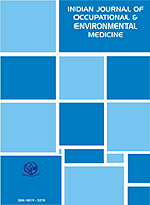
|
Indian Journal of Occupational and Environmental Medicine
Medknow Publications
ISSN: 0973-2284 EISSN: 1998-3670
Vol. 9, Num. 1, 2005, pp. 38-38
|
Indian Journal of Occupational and Environmental Medicine, Vol. 9, No. 1, January-April, 2005, pp. 38
Brief Report
World Health Day 2005 - Implications for occupational health
Kartikeyan S.
PSM Department, Rajiv Gandhi Medical College, Thane,
India
Correspondence Address: S. Kartikeyan, Rajiv Gandhi Medical College,
Kalwa, Thane - 400 605, India. E-mail:
drskartikeyan@rediffmail.com
Code Number: oe05010
The World Health Organization (WHO) was established on 7th April 1948. The WHO celebrates 7th April each year as the World Health Day. A new slogan is coined to focus attention on a particular aspect of health. The slogan for the World Health Day 2005 is "Make every mother and child count".[1]
The well being of societies is directly associated with the health and survival of mothers and children. Many mothers and children are suffering from ill health, poor nutrition and inadequate health care. Each year more than half a million women die from pregnancy-related causes. Each year, 10.6 million children under the age of five years die due to a handful of preventable and treatable illnesses.[1] Newborn babies (less than 28 days old) are at the highest risk of death. Among all child deaths each year, nearly 4 million are among newborns.[2] Many of these deaths can be prevented using affordable and available knowledge and tools. Worldwide, for every two persons who die in traffic accidents, one mother and twenty children die from preventable and treatable causes. In each country, mothers and children from the lower strata of society are the most likely to die.[3]
This day provides a unique opportunity to focus attention on this avoidable tragedy and to stimulate Governments, Organizations and individuals to undertake sustainable activities that aim to improve the health, survival and well being of mothers and children.
Within each household, mothers and children are most vulnerable to ill health. If the working family member does not receive medical benefits, the medical expenses are borne by the family. Thus, ill health is one of the causes of poverty.[4] If the working family member is part of the organized workforce, sickness in the mother or child leads to sickness absenteeism, loss of productivity and increased medical expenses for the organization.
The public health sector, private practitioners, industrial physicians and voluntary organizations need to coordinate action in order to provide mothers and children with an affordable package of proven interventions.
The World Health Day 2005 gives industrial physicians an opportunity to - emphasize the local issues concerning maternal and child health, to highlight the successes achieved by the organization, and to indicate what more can be done to improve the situation.
References
Copyright 2005 - Indian Journal of Occupational and Environmental Medicine
|
